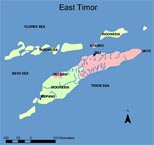East Timor's coffee trees stunted by soil and culture
 Dili - In the high, craggy mountains south of East Timor's capital, Dili, a tangled blanket of wild, unkempt coffee trees is blooming.
Dili - In the high, craggy mountains south of East Timor's capital, Dili, a tangled blanket of wild, unkempt coffee trees is blooming.
If the flowers, now tiny flecks of white against the dark green trees, do well, it could mean more than 7 million dollars in the pockets of some of the poorest people on earth.
It could also mean a hot cup of coffee next year in Hamburg and school fees for a Timorese family.
But it's a long way from flower to bean, and there are no guarantees. These coffee trees are some of the oldest producing trees in the world, grown in some of the worst soil, and they are mismanaged.
This year's crop was a success, largely because of an excellent rainy season. More beans were sold than at any other time since East Timor was a Portuguese colony 33 years ago.
But what about next year? In East Timor, an impoverished South-East Asian nation of 1 million people, coffee is the main export crop and the biggest moneymaker for tens of thousands of farmers, but after six years of independence, coffee production has only just met colonial production levels.
Shane McCarthy is an agribusiness adviser with Co-operativa Cafe Timor (CCT), the largest coffee exporter in the nation. McCarthy has worked for decades on coffee farms around the world, and he said there are unique challenges getting Timorese coffee production back on track, some agricultural and some cultural.
For one thing, most coffee trees the world over are 15 to 20 years old and nestled in volcanic soils. Not so in Timor.
"About 90 per cent of the trees here are over 30 years old," McCarthy said. "Some of the trees are over 70 years old."
And the island of Timor, a far-flung eastern speck in the Indonesian archipelago, is one of the only islands in the chain not of volcanic origin.
The soil there is silt, and at one time, it was a seabed. When most of the coffee trees were planted, East Timor was still a Portuguese colony.
In those days, it rigorously produced coffee, but in 1975, the Portuguese pulled out and Indonesia invaded East Timor, which makes up the eastern half of the island while West Timor, a former Dutch colony, has belonged to Indonesia since 1949.
The coffee districts, those closest to the Indonesian border, were hardest hit by the invasion.
"There was no maintenance of the trees at all," McCarthy said. "No one pruned anything, and no one planted new trees. It was a war zone for 15 years."
During the Indonesian occupation, the coffee industry was taken over by the military.
"They ran the coffee into the ground," McCarthy said. "They harvested coffee at the point of a bayonet."
McCarthy estimated that two generations' worth of farming knowledge was lost and, by the time the Indonesians left, the trees had reverted to wild jungle.
Despite the trees' condition, the lack of skills and the poor soil, the coffee sells. One of the CCT's biggest clients, for example, is the US coffee giant Starbucks Corp.
"This is the only place I know that has ocean-floor limestone soil, and yet miraculously, it is still considered some of the best coffee in the world," McCarthy said, adding, however, "It is also some of the lowest-yielding coffee in the world."
A hectare of coffee plantation in East Timor currently produces about half of what the same plot in neighbouring Papua New Guinea can produce, but getting the right rains at the right time this year helped CCT farmers sell 19,000 tons of coffee cherries, compared with 8,000 tons last year.
Timor Corp, the second-largest coffee exporter in the country, doubled its output to more than 6,000 tons this year. Jose Vidigal, manager of Timor Corp, said nearly all his coffee ends up in Germany, and he has never been able to sell so much since the company started in 2000.
There's not much to be done for the weather, but McCarthy said the CCT is training its members to better care for their trees. He said tree maintenance alone could bump up production by 10 per cent per year.
Lomelino Salsinha is the manager of a CCT tree nursery in the Ermera district, one of the country's chief coffee-growing regions.
No one is expecting 2009 to be another bumper crop. The rains haven't come yet, and there is still a lot of work to do pruning and replacing trees.
Instead, Salsinha said, he is focused on 2012 and beyond. He said he understands that coffee is the key out of poverty for his neighbours.
"When the coffee harvest is good, life here is good," he said. "People have money. They can send their kids to school."
But even after one flush year, Salsinha said, life in Ermera is largely unchanged as most farmers blow their coffee income on parties.
Part of his job, he said, is teaching members of the cooperative to plan for lean years, save their money and take better care of their trees.
Cultural attitudes can hurt coffee production as much as bad soil and old trees, he said.
"People don't save their money," the manager said. "They go out and buy cows or pigs."
"The people here don't really think too much about the coffee plant," Salsinha said. "They just pick the beans and sell it. That's it." (dpa)